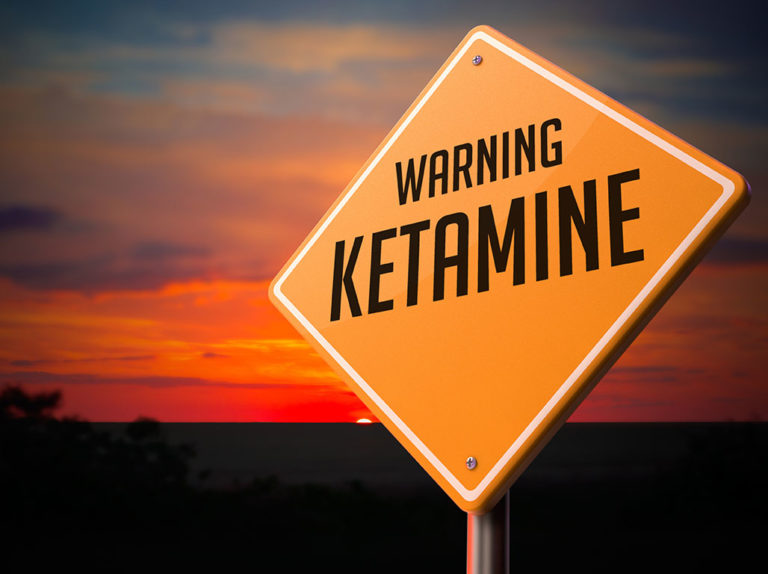Ketamine is considered a dissociative anesthetic (other examples of this drug are PCP and DXM). This means that the drug distorts the users perception of sight and sound and produces feelings of detachment from the environment and oneself.
The drug also has anesthetic properties that have been used in both human and veterinary medicine, and is currently a Schedule III controlled substance. For humans it has been used in radiation and burn therapy, treatment of battlefield injuries, and for children who have adverse reactions to other anesthetics. Ketamine is generally preferred in many of these instances because it does not have as deep a sedative effect as other medications. Along with anesthetic benefits, there are certain reactions to ketamine that make it appealing to illicit users.
In some circumstances, ketamine has been known to produce illusions or hallucinations that are enhanced by environmental stimuli – this may be one reason that the drug has become increasingly popular in the past few years. The most frequent – and sometimes only way – to obtain ketamine is through the diversion or theft of legal pharmaceuticals. There have also been reports of veterinary clinics being robbed for their ketamine supplies. Ketamine has over the past few years been thought of as a ‘club drug’ (this term is used for a number of illicit drugs, primarily synthetics, that are most commonly encountered at nightclubs and “raves”). Though it is difficult to say if ketamine is only used in club settings, research has indicated that nationally in 2002, almost 3% of 12th grade students used ketamine in the past year.
Ketamine History
Ketamine, developed in 1962, was initially promoted as a fast acting general anesthetic. A few years later, in 1970, the federal government approved ketamine for human use, and as a result it soon became popular as a battlefield anesthetic. The first evidence of illicit abuse of the drug was on the West Coast. Later, during the late 1970s and early 1980s abuse began to increase across the country, especially among certain sub-cultures (e.g., mind explorers and New Age spiritualists). Around the same time, new forms of the drug were being introduced into the illegal drug markets including capsules, powder, crystals, tablets, and solutions, in addition to other injectable forms. Starting in the mid-1980s another increase in the social-recreational use of ketamine was beginning to be linked to various dance cultures, initially as an adulterant – an added ingredient that can alter the effects of the drug – of MDMA (ecstasy). In fact there are reports that party/club goers in the United Kingdom first used ketamine when they ingested a pill they thought to be ecstasy. Today, there are still valid medicinal uses of ketamine for anesthetic reasons, though use is uncommon and tightly restricted. Illicit use today is also of great concern to many. Despite difficulty in determining its prevalence, use is higher today than it was when first introduced. Consequently, and perhaps in response to increases in recreational use, the federal government classified ketamine as a Schedule III controlled substance in August 1999, creating more stringent controls of the drug.
Physical Effects of Ketamine
The effects of ketamine are considered dose dependent. That is, lower doses of the drug produce varying results when compared to higher doses. A dose of 1.0 to 2.0 mg per kilogram of body weight produces an intense experience lasting about one hour. The effects include a sense of floating and dissociation, stimulation, and hallucinations. Larger doses of ketamine may produce what users refer to as a “K-hole.” A K-hole is generally reached when the user is on the brink of being fully sedated and is likened to an out-of-body or near-death experience. High doses of ketamine may result in severe respiratory depression, muscle twitches, dizziness, slurred speech, nausea, and vomiting.16 One of the most dangerous effects of ketamine is the helpless and/or confused state the user may be put into after use of the drug. This causes the user to have difficulty with balance, combined with numbness, muscle weakness, and impaired vision. The combined effects can leave the user vulnerable to particular forms of crime,17 especially “date rape”. Other physical side effects for all users can include:
- Flashbacks
- Amnesia
- Impaired motor functioning
- Delirium (hallucinations or disorientation)
- Dramatic increase in heart rate (tachycardia)
- Loss of touch with reality (derealization)
- Loss of coordination
- Sense of invulnerability
- Muscle rigidity
- Aggressive/Violent behavior
- Death from overdose – in severe instances
Methods of Use
In social situations, ketamine is often used intranasally and orally. And though it can be injected, the rapid onset of effects from oral or nasal use makes it more convenient and marketable than the injectable forms.13 It is primarily manufactured as an injectable liquid, however, so illicit producers must evaporate the liquid to form a powder that can be snorted or compressed into pills.14 Each method of ingestion varies in the amount of time it takes to produce affects in the user: injection generally takes between 1 and 5 minutes; snorted ketamine between 5 and 15 minutes; and oral ingestion between 5 and 30 minutes. The hallucinatory effects of ketamine last approximately one hour or less, but the user’s senses, judgment, and coordination may be affected for up to 24 hours following initial use.15
Tolerance, Dependence, and Withdrawal
According to several research studies, there is some evidence that with repeated use ketamine users can develop a tolerance and/or dependence to the drug. Tolerance in many instances can be very high and develop rapidly to the point where after a period of time users will no longer experience the dissociative effects they first began using. Ketamine has a great deal in common with other drugs linked with dependence including stimulants, opiates, alcohol, and cannabis. A common feature of ketamine dependence is that of repeated binges where the user indulges in the drug in excessive amounts over a short period of time. To date, identifying physical withdrawal symptoms has been limited to only personal accounts, but research is ongoing.
Slang Terms for Ketamine
- Special K
- Vitamin K
- K
- Super K
- Ketaset
- Jet
- Super Acid
- Green
- Purple
- Mauve
- Special LA Coke
Courtesy The University of Maryland
If you or someone you know is using Ketamine, visit Recovery Guidance, the free and safe resource to find addiction and mental health professionals near you.
Save
Save





















